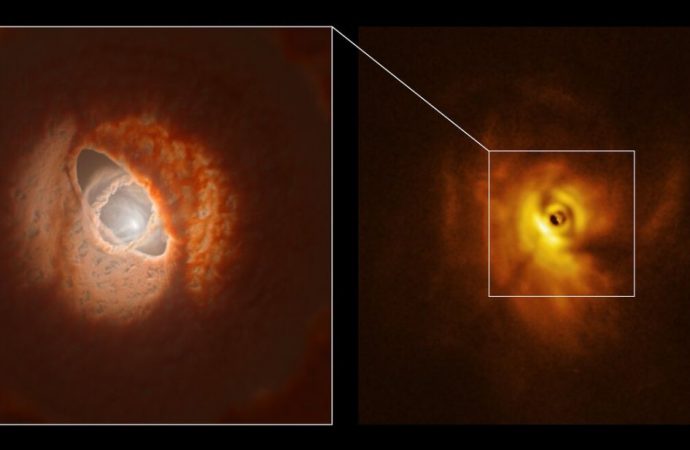Groups of stars can tear their planet-forming disk to shreds, leaving behind warped, misaligned rings, scientists find in a breakthrough study.
Source: Space.com
Solar systems like ours generally form with their planets all orbiting in the same, flat plane. But, as an international team of scientists has found in a new study, this isn’t always the case.
After 11 years of studying GW Orionis, a young triple star system 1,300 light-years away with a circumstellar disk (a planet-forming, ring-shaped disk made up of gas, dust planetesimals, asteroids and more), the team found the first direct evidence that groups of stars can actually tear apart their disks. This work reveals a disk that isn’t flat at all and is, instead, misaligned and broken.
“There have been a number of theoretical studies on disk-tearing effects, but this is the first direct evidence of effect occurring in a planet-forming disk,” study co-author Alison Young of the Universities of Exeter and Leicester in England, told Space.com in an email. “This demonstrates that it is possible for such disks to be warped and broken and raises the possibility that planets could form on highly inclined orbits around multiple star systems.”
The warped ring, which is located in the inner part of the GW Orionis system’s disk, contains 30 Earth-masses of dust, the researchers also found. This means that the disk contains enough material to form planets.
“It’s the best mechanism for forming planets on such extreme orbits, such as been found so far,” lead author Stefan Kraus, a professor of astrophysics at the University of Exeter in the UK, told Space.com, referring to the warping observed in GW Orionis. “But … from the planet-detection side, we don’t have a way of detecting these planets yet.”
While the researchers have yet to detect planets within this system, the groundbreaking study confirms what scientists have suspected for years: that multi-star systems can break their own disks, leaving inclined, misaligned rings around its stars.
Starting in 2008, the researchers, who hail from the UK, Belgium, Chile, France and the US, studied the three newborn stars in the GW Orionis system using the AMBER(Astronomical Multi-BEam combineR) and later the GRAVITY instruments on the European Southern Observatory’s Very Large Telescope (VLT) in Chile, which combines the light from different telescopes.
“This data allowed us to build a detailed computer model of the system, which predicted that the circumstellar disk would be bent and even torn to form a separate inner ring,” Young said.
“When we got the first orbit solution, which was about 2016, we then noticed that there is this misalignment between the orbits themself,” Kraus said, elaborating to say that the theorists on the team predicted that the system could be susceptible to disk tearing.
With this computer model in hand, the team then made observations of the system with the SPHERE (Spectro-Polarimetric High-contrast Exoplanet REsearch) instrument on VLT and with the Atacama Large Millimeter/submillimeter Array (ALMA), the largest radio telescope in the world.
“When we received the data from the VLT and ALMA, the images were stunning. We saw this ring clearly in the ALMA observations and the tell-tale shadow in the VLT image which could only be cast by an inclined ring,” Young said.
The results confirmed the ring’s misalignment and showed that what they suspected all along was happening 1,300 light-years away.
“It is exciting to see mathematical predictions verified in observations so clearly. I find the SPHERE image particularly amazing because we can really see the disk is a 3-dimensional structure with a surface covered in bumps and shadows,” Young said. “We are looking at what could eventually become an unusual type of planetary system in the very process of forming.”
This work was published today (Sept. 3) in the journal Science.
Source: Space.com

































Leave a Comment
You must be logged in to post a comment.